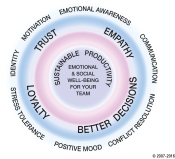 Frequently encountered emotional intelligence (EI) pitfalls that limit relationships and productivity at work are numerous. Ordering people to just “get it done” could well be the top pitfall of all. Do you agree? Several pitfalls and better EI Options are listed below.
Frequently encountered emotional intelligence (EI) pitfalls that limit relationships and productivity at work are numerous. Ordering people to just “get it done” could well be the top pitfall of all. Do you agree? Several pitfalls and better EI Options are listed below.
- Pitfall: Just tell your direct reports or others to do something.
- Better EI Option: Use your EI skills in empathy and assertiveness to influence others to want to engage in your project.
Pitfalls sabotage your success. When you just tell people to do something and you don’t take a few minutes to acknowledge them, build buy-in and guide understanding, you often invite opposition and resistance. Ironically you might have been so directive because you felt you didn’t have time for more engagement, yet the resistance will cost you more time in the long run.

- Pitfall: Order your direct reports or others to be happy and engaged.
- Better EI Option: Create a culture that builds skills in optimism, self-regard and emotional expression and thus supports staff agility and buy in. These and other EI skills are central to building an engaged culture with a “can-do” attitude. Your leadership has a lot to do with the responses you get. If you want happy and engaged direct reports, use positive language that supports optimism. For example, express the belief that together all of you will meet the big challenge, you just don’t know how yet. That wonderful word “yet” establishes the presupposition of success, and that helps create the outcome you’re looking for.

- Pitfall: Ignore the impact of reassigning employees who have become friends and are working effectively as team members.
- Better EI Option: Respond to and acknowledge relationships, notice how they support or weaken team work. When you need to make new assignments, help people process and accept the change.
- Pitfall: Insist that emotions be left at the door when it’s time to solve problems.
- Better EI Option: Use all your smarts in solving problems; that is both your IQ and your EQ. People can’t think without using their emotions. So the question becomes whether you and your team want to be aware of your emotional responses, including your intuitive awareness, and factor in all your data when resolving the problem. We suspect people seek to avoid their emotions when they are afraid they don’t have the skills to manage the emotions successfully. However, this strategy frequently backfires as the emotions will leak out in some poorly managed format. It’s better to get training and coaching and be fully in charge of your responses.

- Pitfall: Blast your stress on all in your path.
- Better EI Option: Learn strategies to regain your equilibrium when your buttons are pushed, then talk to others. You can breathe, use stair therapy, count to 10, any number of strategies work. Just give yourself time to avoid the adverse consequences of getting all tied up in knots! The key point is get more oxygen to your brain and give yourself a few minutes before you respond. Stair therapy is one of our favorites. When you feel triggered, tired or cranky go climb a set of stairs then come back to your office or to the situation and respond. Your renewed resilience will invite more welcome responses.



 Posted by Marcia Hughes
Posted by Marcia Hughes  Collaboration is a result of people working together to reach a mutual answer to a challenge or opportunity. As our world becomes more integrated and boundaries become more blurred the need and desire to collaborate is heightened. We see this on the internet, such as with Wikipedia, in organizations of all sizes and shapes, such as the better efforts at the United Nations and in performance goals for individuals and leaders, such as the Executive Core Qualifications (ECQ’s) that leaders in the federal senior executive service are to meet.
Collaboration is a result of people working together to reach a mutual answer to a challenge or opportunity. As our world becomes more integrated and boundaries become more blurred the need and desire to collaborate is heightened. We see this on the internet, such as with Wikipedia, in organizations of all sizes and shapes, such as the better efforts at the United Nations and in performance goals for individuals and leaders, such as the Executive Core Qualifications (ECQ’s) that leaders in the federal senior executive service are to meet.  Collaborative Intelligence™
Collaborative Intelligence™ 